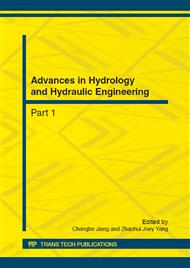p.878
p.883
p.887
p.891
p.895
p.899
p.904
p.912
p.917
Study on Concrete Temperature Crack Based on Mesomechanics
Abstract:
A three-phase mesomechanics model was established to simulate the aggregate, cement mortar and the interface between them. In order to reflect the meso characters and heterogeneity of concrete, the parameters were randomly valued on the Weibull distribution. Then, by using this model the complete process of concrete crack propagation was analyzed based on the elastic brittle damage theory. This method was verified by simulation of uniaxial tension and three-point bend beam test. Finally, concrete structure cracking at early age during a cold snap was simulated under different surface insulation conditions. The results show that this method can simulate the crack initiation and propagation effectively and reflect the whole process of concrete crack under temperature load.
Info:
Periodical:
Pages:
895-898
Citation:
Online since:
October 2012
Authors:
Keywords:
Price:
Сopyright:
© 2012 Trans Tech Publications Ltd. All Rights Reserved
Share:
Citation:


